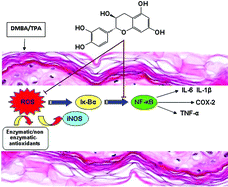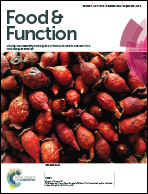Topical (+)-catechin emulsified gel prevents DMBA/TPA-induced squamous cell carcinoma of the skin by modulating antioxidants and inflammatory biomarkers in BALB/c mice†
Abstract
An emulsified gel of (+)-catechin was developed and evaluated topically against 7,12-dimethylbenz(a)anthracene-induced and 12-O-tetradecanoylphorbol-13-acetate-promoted (DMBA-induced and TPA-promoted) squamous cell carcinoma of the skin in BALB/c mice. The biological evaluation outcome indicated that the (+)-catechin emulsified gel increased the activity of oxidative stress biomarkers glutathione (GSH), superoxide dismutase (SOD), catalase (CAT), glutathione S-transferase (GST), glutathione reductase (GR), and glutathione peroxidase (GPx), whereas it decreased the level of malondialdehyde (MDA). The mechanistic study showed that genes implicated in the inflammation and cancer, such as cyclooxygenase-2 (COX-2), nuclear factor-kappa B (NF-κB), and inducible nitric-oxide synthase (iNOS), were down-regulated by (+)-catechin emulsified gel while inhibiting an inflammatory mediator prostaglandin E2 (PGE2). The (+)-catechin emulsified gel further suppressed the activity of pro-inflammatory cytokines, viz. tumor necrosis factor-alpha (TNF-α), interleukin-1 beta (IL-1β), and interleukin-6 (IL-6). The in vitro permeation study revealed that release of (+)-catechin from an emulsified gel base reached a steady state after 6 h, while pH of the entire emulsified gel was found to be between 6.2 and 6.5 that falls well within the normal pH range of the skin.


 Please wait while we load your content...
Please wait while we load your content...